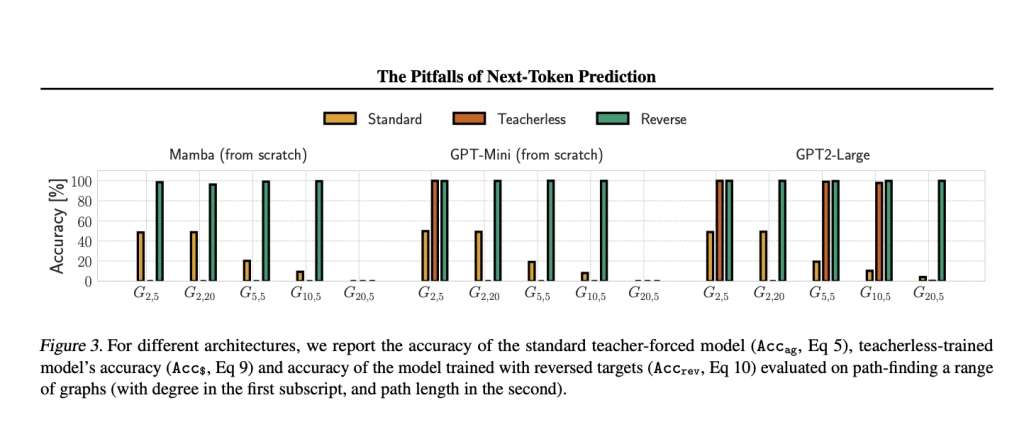Beyond Next-Token Prediction: Overcoming AI’s Foresight and Decision-Making Limits

One of the emerging challenges in artificial intelligence is whether next-token prediction can truly model human intelligence, particularly in planning and reasoning. Despite its extensive application in modern language models, this method might be inherently limited when it comes to tasks that require advanced foresight and decision-making capabilities. This challenge is significant as overcoming it could enable the development of AI systems capable of more complex, human-like reasoning and planning, thus expanding their utility in various real-world scenarios.
Current methods, primarily relying on next-token prediction through autoregressive inference and teacher-forcing during training, have been successful in many applications, such as language modeling and text generation. However, these methods face significant limitations. Autoregressive inference suffers from the compounding of errors, where even minor inaccuracies in predictions can snowball, leading to substantial deviations from the intended sequence over long outputs. Teacher-forcing, on the other hand, fails to accurately learn next-token prediction in certain tasks. This method can induce shortcuts, leading to a failure in learning the true sequence dependencies necessary for effective planning and reasoning. These limitations hinder the performance and applicability of current AI models, particularly in tasks requiring complex, long-term planning and decision-making.
The researchers introduce a novel approach by advocating for a multi-token prediction objective, which aims to address the shortcomings of existing next-token prediction methods. This approach proposes predicting multiple tokens in advance rather than relying solely on sequential next-token predictions. By doing so, it mitigates the issues arising from error compounding in autoregressive inference and the shortcut learning in teacher-forcing. This innovation is significant because it offers a more robust and accurate method for sequence prediction, enhancing the model’s ability to plan and reason over longer sequences. This approach represents a significant contribution to the field by potentially enabling more complex and reliable AI models.
The proposed method involves predicting multiple tokens at once during training, thus avoiding the pitfalls of traditional teacher-forcing and autoregressive methods. The researchers designed a minimal planning task using a path-finding problem on a graph to empirically demonstrate the failure of traditional methods. Both the Transformer and Mamba architectures were tested, revealing that these models fail to learn the task accurately under traditional next-token prediction methods. The dataset used consisted of path-star graphs with varying degrees and path lengths, and the models were trained to find paths from a starting node to a goal node. Key technical aspects include the specific graph structure used, the model architectures tested, and the experimental setup ensuring in-distribution evaluation to accurately assess model performance.
The findings show that both the Transformer and Mamba architectures failed to accurately predict the next tokens in the path-finding task when using traditional methods. Traditional next-token prediction methods exhibited significant limitations, with errors compounding and leading to substantial inaccuracies in long sequences. The proposed multi-token prediction approach, however, demonstrated a significant improvement in accuracy and performance. This method successfully mitigated the issues seen with autoregressive inference and teacher-forcing, achieving higher accuracy in the path-finding task and showcasing its effectiveness in enhancing sequence prediction capabilities.
In conclusion, “The Pitfalls of Next-Token Prediction” addresses the critical challenge of whether next-token prediction can faithfully model human intelligence, particularly in tasks requiring planning and reasoning. The researchers propose a novel multi-token prediction approach that mitigates the limitations of traditional methods, demonstrating its effectiveness through empirical evaluation on a path-finding task. This approach represents a significant advancement in AI research, offering a more robust and accurate method for sequence prediction. The contribution lies in highlighting the limitations of current methods and providing a promising alternative that enhances the planning and reasoning capabilities of AI models.
Check out the Paper. All credit for this research goes to the researchers of this project. Also, don’t forget to follow us on Twitter.
Join our Telegram Channel and LinkedIn Group.
If you like our work, you will love our newsletter..
Don’t Forget to join our 46k+ ML SubReddit
Aswin AK is a consulting intern at MarkTechPost. He is pursuing his Dual Degree at the Indian Institute of Technology, Kharagpur. He is passionate about data science and machine learning, bringing a strong academic background and hands-on experience in solving real-life cross-domain challenges.










